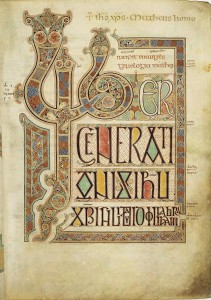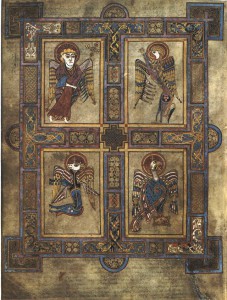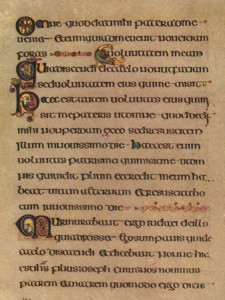Spotlight Text of the Month: Book of Kells Posted by Brittany Britanniae on Apr 8, 2015 in Latin Language
Salvete Omnes!
I have been giving it some series thought and I think it would be a great monthly post addition to have Spotlight Texts! By this I mean to summarizes a text of Latin in all its major facets and include an excerpt from the text with Latin and English. This week I thought we would start with one the most famous intact Latin texts: Book of Kells! Also, I have been watching the History Channel’s Vikings a little too much and wanted to do a text not from Ancient Rome.

Book of Kells. Folio 27r from the Lindisfarne Gospels contains the incipit Liber generationis of the Gospel of Matthew. Compare this page with the corresponding page from the Book of Kells (see here), especially the form of the Lib monogram. Courtesy of WikiCommons.
|
Vulgate. |
Book of Kells. |
| Caenantibus autem eis accepit Iesus panem et benedixit ac fregit deditque discipulis suis et ait Accipite et comedite; hoc est Corpus meum.
And as they were eating, Jesus took bread, and blessed it, and brake it, and gave it to the disciples, and said, Take, eat; this is my body. Matth. xxvi. 26. |
. . . . . accipit . . . . . . . . discipulis suis dicens accipite edite ex hoc omnes hoc est enim Corpus meum quod confringitur pro saeculi vita.
|
| Heli heli lema sabacthani.
And about the ninth hour Jesus cried with a loud voice, saying, Eli, Eli, lama sabachthani? that is to say, My God, my God, why hast thou forsaken me? Ib. xxvii. 46. |
Heli heli laba sabacthani.
|
| Ceteri vero dicebant sine videamus an veniat Helias liberans eum.
The rest said, “Now leave him alone. Let’s see if Elijah comes to save him
Ib. xxvii. 49.
|
. . . Helias et liberaret eum.
|
| Factum est autem in diebus illis exiit edictum a Caesare Augusto ut describeretur universus orbis.
In those days Caesar Augustus issued a decree that a census should be taken of the entire Roman world.
Luke ii 1.
|
in illis diebus . . . accessare agusto ut censum profiterentur universi per orbem terrae
|
|
ut profiteretur cum Maria desponsata sibi uxore praegnante.
He went there to register with Mary, who was pledged to be married to himand was expecting a child.
Ib. ii. 5. |
. . . sibi disponsata . . praegnante de spiritu sancto. |
| et videbit omnis caro salutare dei.
And all people will see God’s salvation.’
Ib. iii. 6.
|
et videbitur maies [sic] domini. |
| genimina viperarum.
John said to the crowds coming out to be baptized by him, “You brood of vipers! Who warned you to flee from the coming wrath?
Ib. iii. 7.
|
o generatio viperarum. |
| adveniat regnum tuum: panem nostrum cotidianum da nobis cotidie.
your kingdom come:Give us each day our daily bread
Ib. xi. 2-3.
|
adveniat regnum tuum: fiat voluntas tua sicut in coelo et in terra, da nobis hodie |
|
Vulgate. |
Book of Kells. |
|
[No corresponding passage.]
|
[At end of verse:] |
| et depositum involvit sindone, et posuit eum in monumento exciso, in quo nondum quisquam positus fuerat.
Then he took it down, wrapped it in linen cloth and placed it in a tomb cut in the rock, one in which no one had yet been laid.
Ib. xxiii. 53.
|
. . . . in sindone munda . . . . . . . . . . . et imposito eo imposuit monumento lapidera magnam. |
| Et cum dixisset, statim discessit al eo lepra, et mundatus est.
And this was his message: “After me comes the one more powerful than I, the straps of whose sandals I am not worthy to stoop down and untie.
Mark i. 17
|
[After mundatus est] et inspiciens Iesus austri vultu eicit eum. |
| grex porcorum magnus pascens.
A large herd of pigs was feeding on the nearby hillside.
MARK. v. 11.
|
. . . . . . pascensium [sic] |
| et videt tumultum.
When they came to the home of the synagogue leader, Jesus saw a commotion, with people crying and wailing loudly.
Ib. v. 38.
|
vidit cumuultum [sic].
|
| Et angariaverunt praetereuntem quempiam.
A certain man from Cyrene, Simon, the father of Alexander and Rufus, was passing by on his way in from the country, and they forced him to carry the cross.
Ib. xv. 21.
|
. . . . angarizaverunt . . . . |
| Quod natum est ex carne caro est, et quod natum est ex spiritu spiritus est.
Flesh gives birth to flesh, but the Spiritgives birth to spirit
John iii. 6.
|
Quod natum est ex carne caro est quia de carne natum est, et quod natum est ex spiritu spiritus est quia deus spiritus est et ex deo natus est. * |
Well that was a lot to translate!

Build vocabulary, practice pronunciation, and more with Transparent Language Online. Available anytime, anywhere, on any device.
About the Author: Brittany Britanniae
Hello There! Please feel free to ask me anything about Latin Grammar, Syntax, or the Ancient World.






Comments:
T:
Salve,
Where do you find the text from the Book of Kells. All my searching thus far has led to links about the book and about the text, but not to the text itself.
Surely someone has posted the entire manuscript in text form (with variant interpretations ) in Latin.
Gratias tibi ago,
Brittany Britanniae:
@T Try here! http://www.sacred-texts.com/neu/celt/bok/index.htm Unless you are looking no for images of the text but the actual text copied/type out. Let me know!
John Litteral:
I saw in a quote that the book of Kells has a harmony of the four evangelists according to St. Jerome. Is this a work like St. Augustine’s harmony on the Gospels? Also, will there be any translating of the Catena on the Gospels found in the book of Kells?